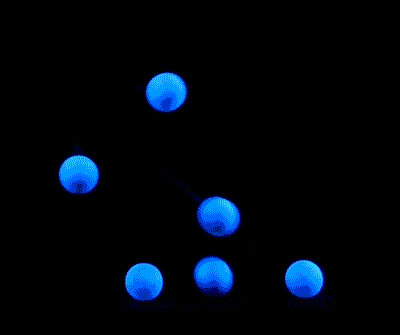The Parachute
 Young and full of energy we set off on life’s adventure. We find love, build homes and have babies. Then suddenly the children have left, and home feels like a waiting room. That’s the moment to strap on a parachute and take charge of things for that final leap into the unknown…
Young and full of energy we set off on life’s adventure. We find love, build homes and have babies. Then suddenly the children have left, and home feels like a waiting room. That’s the moment to strap on a parachute and take charge of things for that final leap into the unknown…
The Parachute is a funny and mesmerising story about youth, love and confronting old age. Armed with Sebastian Castagna’s glorious music and an armful of white tipped wands, puppeteer Stephen Mottram magics up his characters from nowhere. He plays with the way our brains make sense of things we see and stealthily reels us into a world of movement, populated by captivating, non-existent actors.
 In 1971, The Swedish Psychologist Gunnar Johansson attached white markers to a few key points on a black-costumed actor’s body and then filmed the actor walking against a black background. When the film was played back, he was surprised to find that the white spots seen moving relative to each other on the screen contained so much information, that not only could the viewer immediately identify a human walking, but also the gender, age and mood of the person.
In 1971, The Swedish Psychologist Gunnar Johansson attached white markers to a few key points on a black-costumed actor’s body and then filmed the actor walking against a black background. When the film was played back, he was surprised to find that the white spots seen moving relative to each other on the screen contained so much information, that not only could the viewer immediately identify a human walking, but also the gender, age and mood of the person.
Johansson’s research was the gold nugget which led the film industry to the techniques of motion capture. In The Parachute Stephen Mottram uses the idea in reverse. The white tips of his multiple magic wands reveal ephemeral characters whose lives we end up caring about.
"The audience sees characters which don’t exist. The behaviour of the white spots they watch refers to key elements of human weight and balance and how our bodies move in a space. The brain of the audience member – hardwired to scan for signs of life – interprets the data in the movements and ‘sees’ a character. This perceptual ‘game’ between the performer and audience is hugely enjoyable.
When we look at classic Op-Art, the stark contrasts in colour and shape – black circles and diagonal patterns superimposed on each other for example, confuse our brains. We see movement and flashing light, but we know it comes from our brain and not from the picture. I like the idea that the performer can direct an audience to perceive a story in their own heads, simply by providing the most basic of performed data."
Stephen Mottram 2016
Technical
 Stage space: ideally a black box at least 3m X 3m with a minimum 2.3m headroom. The blackout in the room needs to be good since the performance uses UV lighting effects.
Stage space: ideally a black box at least 3m X 3m with a minimum 2.3m headroom. The blackout in the room needs to be good since the performance uses UV lighting effects.
Get-in minimum 2 hours, Get out 50 minutes
The performance is directed at adult audiences, but is not unsuitable for younger people. We recommend a maximum audience size of 100 people
"Mottram takes the craft of puppetry to a level of sophistication that makes you gasp with the cleverness of it"
Independent on Sunday

